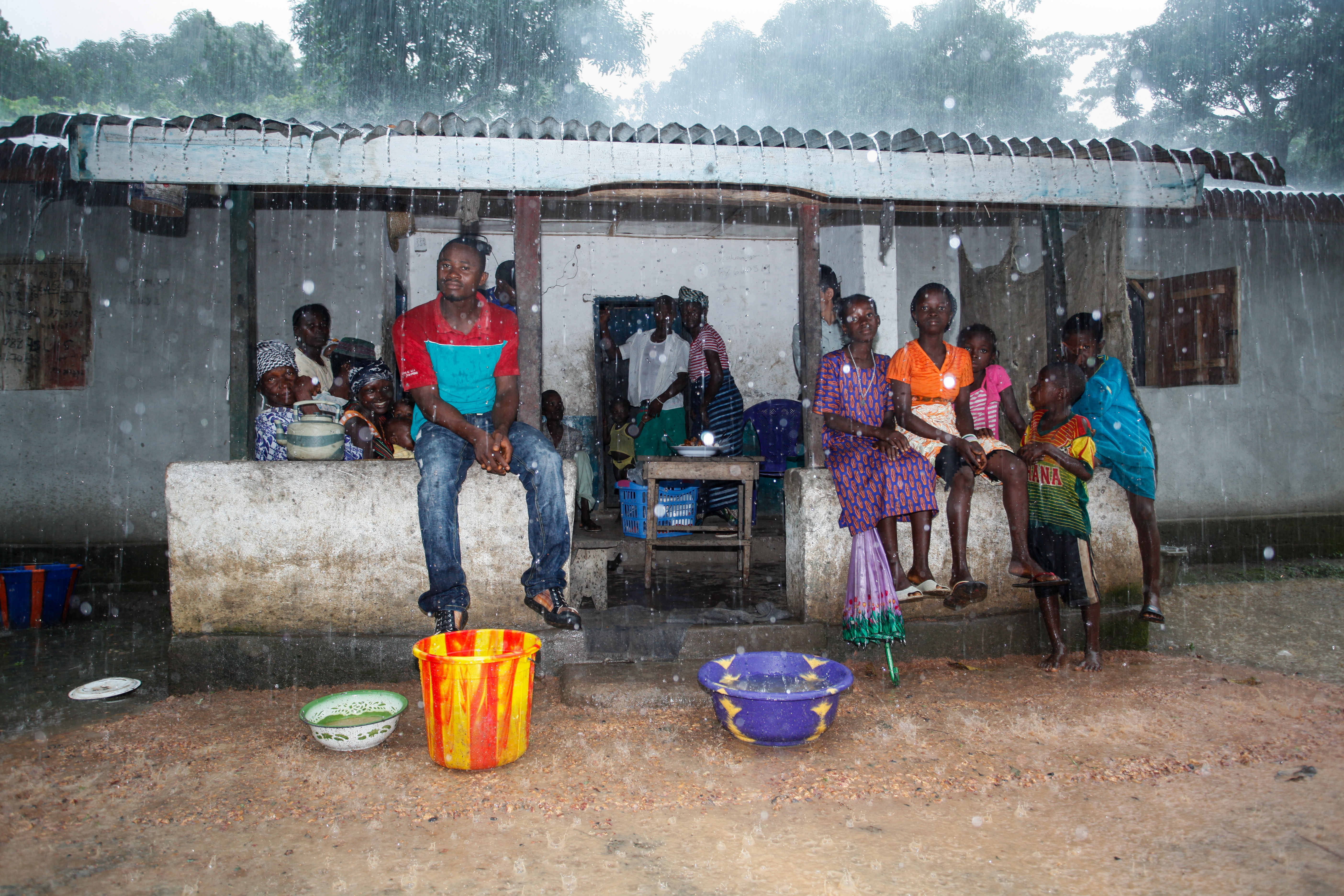Blog: Realizing Development That Can Withstand Uncertain Changes in Climate and Society
2023.07.12
At the JICA Ogata Sadako Research Institute for Peace and Development (JICA Ogata Research Institute), researchers with a wide range of experience and backgrounds are forging partnerships with diverse stakeholders and partners. We will share their knowledge and perspectives gained from their research activities in this blog post series. Sato Ichiro, executive senior research fellow, wrote this blog post to discuss how we should move development cooperation forward effectively while overcoming uncertainties like climate change.
Author: Sato Ichiro, executive senior research fellow, JICA Ogata Research Institute
In recent years, climate change is increasingly receiving attention. Development cooperation can no longer be discussed without due considerations to climate change. We are now required to consider reducing greenhouse gas emissions and adapting to climate change in any development project. While the extent of climate change impacts varies depending on project types, large-scale infrastructure development projects whose operational life spans several decades, and long-term development planning projects, such as those on urban development, are likely to be greatly impacted. This is because climate change impacts are thought to become more significant over the coming several decades: development projects with long-lasting effects are at greater risk of being exposed to greater impacts of climate change.
Today, when infrastructure development plans or long-term development plans are formulated, climate change impacts are considered more often than ever. Although this is a preferable change, there is one major problem: some climate change impacts are difficult to foresee. For instance, compared to sea level rise or changes in average temperature, changes in precipitation are known to be difficult to predict. This is especially the case with the impacts of climate change on local extreme events such as torrential rain. The complexity of the underlying mechanisms and the small spatial scale of these phenomena are among the reasons behind this. Factors like the area and topographic features of the land covered by the project can also affect prediction accuracy. What is more, uncertainty factors that are hard to predict but may influence the success or failure of the project are not limited to climate change impacts. Socioeconomic uncertainties such as population migration, changes in markets, and policy shifts, can also have significant impacts on development projects.

Sierra Leonean people who take shelter to avoid sudden heavy rain (Photo: JICA/ Iizuka Akio)
The responses of project planners to hard-to-predict climate change impacts or other uncertainties, generally fall into three groups.
The first is to take a business-as-usual approach to planning as if there are no uncertainties. In this case, future predictions are made with certain assumptions on uncertainty factors, or such factors are disregarded entirely. Based on these predictions, the optimum plan is developed after considering various limitations (e.g., budget constraints). With this approach, however, the outcome could end up being unexpectedly disappointing if the predictions turn out to be wrong.
The second is to make an effort to reduce uncertainties. For example, by collecting more local data to improve simulation models and improving the accuracy of predictions, uncertainties around climate change impacts may be reduced. Although investments in such efforts are valuable in some cases, these efforts tend to be time-consuming and are therefore often unattainable within the project timeframe. Furthermore, the phenomenon to be modeled for predictions could be too complex to be modelled with reasonable accuracy. Moreover, some uncertainties cannot be reduced no matter how much data are fed in and models are improved. This is typical with events that are subject to natural randomness. Take for example, a situation where a natural random gene mutation in a plant species in a vegetation community ends up changing the entire species composition. No matter how much data (on soil, water, light and temperature, etc.,) are collected to improve the simulation model, it will be almost impossible to predict how such a mutation will affect the composition of the vegetation over time.
The final option is to acknowledge and accept that uncertainties do exist, look into their impacts, and try to plan a project in a way that the outcomes do not depend on uncertainties as much as possible. Sensitivity analysis (*1), which is already widely applied, is seen as one way of attempting this. However, since sensitivity analysis usually looks at how the outcome is affected when one uncertainty factor is changed within a certain range, it cannot handle situations where a combination of multiple uncertainty factors collectively affects the outcome.
Another process that has been in use for a while is adaptive project planning and management. In this process, the project is implemented based on the initial plan, while at the same time, changes in uncertainty factors and their implications are monitored. Based on the monitoring results, adjustments are made to the plan as it gets implemented. Although this is an effective way, it has a weak point: There is a risk for the project to end up choosing a pathway that has no room for adjustments.
Let us consider an example situation, in which a plan is made to make levees higher to address future increase in flood discharge caused by climate change. Changes in flood discharge are monitored over the years and levees are elevated in response. However, the peak flood discharge may increase to the point that it is no longer possible to make the levees any higher. It also may become impossible to expand the river width because of the surrounding residential areas leaving no more space for the levees or the river to expand. Another example situation is where irrigation infrastructure is built and water conservation technologies and/or drought-tolerant crops are considered in order to prepare for less precipitation and less water availability. However, the decrease in precipitation may be significantly greater than forecasted, to the point that the irrigation infrastructure itself becomes useless.
(*1) Sensitivity analysis in the context of development project planning is a process to analyze how project outcome will change in response to changes in factors that affect the project.
In Phnom Penh, the capital of Cambodia, plans to protect the city from floods are under development (Photo: JICA)
In order to avoid such situations, many possible scenarios need to be considered at the initial planning stage to work toward a plan that allows for goals to be achieved under the broadest possible range of scenarios. There is a group of methods that can help such planning. This is referred to as “decision making under deep uncertainty (*2).” In particular, a framework called robust decision making (RDM) (*3) is increasingly getting applied to issues around climate change adaptation in development projects over the past decade or so.
In RDM, many scenarios are prepared with various combinations of uncertainty factors that may greatly influence the success or failure of a plan. By using simulation models that can assess the performance of the plan, all scenarios are applied to identify which scenarios, when realized, will put the achievement of the goals of the plan at risk. In this way, the vulnerabilities of the plan against uncertainty factors can be visualized and the plan is modified to mitigate these. This process is repeated until a robust plan is identified, in which vulnerability is controlled to the greatest possible extent. In the context of climate change adaptation, while some climate change impacts are important uncertainties, these are not the only important ones. In most cases, various socioeconomic factors also make up key uncertainties. This is an important point, suggesting that RDM may be effective not only for climate change adaptation projects but also in any type of development project where the presence of uncertainties is an issue.
Note that, in RDM, it is a standard practice to have repeated stakeholder consultations to identify and select key uncertainties, development options to be included in the plan, and metrics to assess the outcomes of the plan. In the case of development cooperation projects, stakeholders may include officials of relevant government departments, those involved in project implementation, representatives of local communities or other parties that are affected (positively or negatively) by the project. Project modifications in response to simulation results will also be carried out through dialogues with stakeholders. RDM is only an analysis tool to assist decision making after all, and it is the stakeholders who make decisions.
Of course, RDM has its limitations. No matter how many sets of analysis and plan modifications are repeated, it is difficult to eliminate vulnerability because of constraints in available funds and resources, and the measures that can be taken have their limits too. Moreover, while it is common to use simulation models that are run by computers to apply many scenarios (although it may be possible to calculate manually if the model is simple and sufficient time and labor are available), reliable models or sufficient data needed for simulation may not be available. What is more, as the scenarios that can be analyzed by RDM are limited to those that are conceivable for stakeholders, RDM cannot address “black swan” events that are out of the imagination for stakeholders. Since the analysis process through repeated consultation with stakeholders requires time, effort and financial resources, there may be cases where RDM cannot be applied because of time and budget constraints.
Despite limitations like these, RDM is potentially an effective tool that could facilitate development planning to become more robust against the uncertain impacts of climate change. JICA Ogata Research Institute has leveraged RDM to work on a case study on irrigation development projects in Kenya (*4) and a new study that looks at an urban flood mitigation plan in Sri Lanka (*5). On top of the uncertainties of climate impacts, the modern world is full of a whole range of uncertainties, including conflicts and pandemics, which make compound impacts on development. To address these challenges, a paradigm shift is in need: we need to depart from the conventional paradigm that neglects uncertainties or focuses only on reducing uncertainties, and try to mitigate the impacts of uncertainties based on a humble recognition of the limit of our knowledge and the ability to predict the future.
(*2) Marchau, V.A.W.J., Walker, W.E., Bloemen, P.J.T.M., Popper, S.W. (Eds.), 2019. Decision Making under Deep Uncertainty: From Theory to Practice. Springer Nature.
(*3) Lempert, R.J., Popper, S.W., and Banks, S.C. 2003. Shaping the Next One Hundred Years: New Methods for Quantitative, Long-Term Policy Analysis. RAND Corporation.
(*4) Narita, D., Sato, I., Ogawada, D., Matsumura, A., 2022. Evaluating the robustness of project performance under deep uncertainty of climate change: A case study of irrigation development in Kenya. Climate Risk Management 36, 100426.
(*5) Study on quantitative evaluation of climate change adaptation benefits of urban flood management | Research Activities - JICA Ogata Research Institute
Note: This blog expresses the individual views of the author, not the views of JICA nor of the JICA Ogata Sadako Research Institute for Peace and Development.
Sato Ichiro:
Sato is an executive senior research fellow at the JICA Ogata Research Institute since 2022. He joined Japan International Cooperation Agency in 1997 and has worked at its Mexico Office, Brazil Office, Disaster Risk Reduction Group, and the Office for Climate Change. He was seconded to the World Resources Institute from 2018 to 2020.

Experts| SATO, Ichiro
Project| Study on quantitative evaluation of climate change adaptation benefits of urban flood managementResearch Activities
Project|
Economic Evaluation of Adaptation Measures to Climate Change under Uncertainty

事業事前評価表(地球規模課題対応国際科学技術協力(SATREPS)).国際協力機構 地球環境部 . 防災第一チーム. 1.案件名.国 名: フィリピン共和国.

事業事前評価表(地球規模課題対応国際科学技術協力(SATREPS)).国際協力機構 地球環境部 . 防災第一チーム. 1.案件名.国 名: フィリピン共和国.

事業事前評価表(地球規模課題対応国際科学技術協力(SATREPS)).国際協力機構 地球環境部 . 防災第一チーム. 1.案件名.国 名: フィリピン共和国.

事業事前評価表(地球規模課題対応国際科学技術協力(SATREPS)).国際協力機構 地球環境部 . 防災第一チーム. 1.案件名.国 名: フィリピン共和国.

事業事前評価表(地球規模課題対応国際科学技術協力(SATREPS)).国際協力機構 地球環境部 . 防災第一チーム. 1.案件名.国 名: フィリピン共和国.
scroll